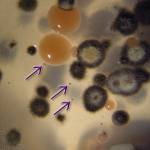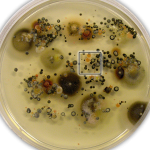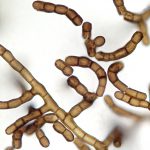The Distilleries’ Shadow: A summary of knowledge about Baudoinia, the warehouse staining fungus
Published: May 1st, 2008
Revised: August 18th, 2009
 During the 1870s, the pharmacist Antonin Baudoin called attention to a black, soot-like growth on buildings near spirit maturation warehouses in the famous town of Cognac, France. The nature of the dark “cryptogamic plant” growing on walls, roof tiles, tree trunks and fences was debated by the experts: was it a fungus or a blue-green alga? In 1881, it was definitively classified as a fungus and named Torula compniacensis (meaning ‘the torula from Cognac,’ popularly known as “la torule” in Cognac itself. The old genus name Torula, from 1794, means “little rounded thing.”). Then, remarkably, the fungus was forgotten by science for 80 years. It was briefly studied by Scandinavian and French researchers in the 1960s, then forgotten again. Finally, in the late 1990s, when the public became aware of health problems associated with the growth of black moulds in water-damaged buildings, the widespread occurrence of soot-like fungal growth around distilleries attracted attention and aroused suspicion.
During the 1870s, the pharmacist Antonin Baudoin called attention to a black, soot-like growth on buildings near spirit maturation warehouses in the famous town of Cognac, France. The nature of the dark “cryptogamic plant” growing on walls, roof tiles, tree trunks and fences was debated by the experts: was it a fungus or a blue-green alga? In 1881, it was definitively classified as a fungus and named Torula compniacensis (meaning ‘the torula from Cognac,’ popularly known as “la torule” in Cognac itself. The old genus name Torula, from 1794, means “little rounded thing.”). Then, remarkably, the fungus was forgotten by science for 80 years. It was briefly studied by Scandinavian and French researchers in the 1960s, then forgotten again. Finally, in the late 1990s, when the public became aware of health problems associated with the growth of black moulds in water-damaged buildings, the widespread occurrence of soot-like fungal growth around distilleries attracted attention and aroused suspicion. 
 The nature of the fungus, however, baffled modern experts: ordinary culturing techniques as well as the most modern genetic sampling techniques were confounded by a dusting of ubiquitous, contaminating “weed” fungi that accumulated on top of the primary black growth. Eventually, the problem was solved by using very patient culturing with an unusual twist: since the fungus seemed to grow only where ethanol vapours were present in the air, ethanol was also added to the growth medium at low concentration. Even though the fungus was extremely slow growing, it then grew well enough to be sorted out from the overlying “weeds” and brought into pure culture.
The nature of the fungus, however, baffled modern experts: ordinary culturing techniques as well as the most modern genetic sampling techniques were confounded by a dusting of ubiquitous, contaminating “weed” fungi that accumulated on top of the primary black growth. Eventually, the problem was solved by using very patient culturing with an unusual twist: since the fungus seemed to grow only where ethanol vapours were present in the air, ethanol was also added to the growth medium at low concentration. Even though the fungus was extremely slow growing, it then grew well enough to be sorted out from the overlying “weeds” and brought into pure culture.
 The fungus grows as dark spots, streaks or clumps that under the microscope can be seen to be composed of short chains of dark, rounded cells. The cells have a rough wall; that and the fact that the chains break into fragments tend to make la torule look like microscopic dead debris. By comparison, the more elegantly formed cells of co-occurring “weed” fungi like Cladosporium are more likely to attract attention. To determine the biological relationship of the very nondescript torule, modern gene sequencing techniques were necessary. Remarkably, the organism was found to be most closely related to a fungal family, the Friedmanniomycetaceae, best known for growing inside porous rocks in Antarctica. Since it was completely unrelated to any fungus correctly called Torula, it had to be given a new scientific genus name. The name “Baudoinia” was chosen, after the pharmacist who first brought the fungus to scientific attention. The most typical cultures thus became the species Baudoinia compniacensis, “Baudoin’s [fungus] from Cognac.” Other, still-undescribed species of Baudoinia occur in numerous locales worldwide.
The fungus grows as dark spots, streaks or clumps that under the microscope can be seen to be composed of short chains of dark, rounded cells. The cells have a rough wall; that and the fact that the chains break into fragments tend to make la torule look like microscopic dead debris. By comparison, the more elegantly formed cells of co-occurring “weed” fungi like Cladosporium are more likely to attract attention. To determine the biological relationship of the very nondescript torule, modern gene sequencing techniques were necessary. Remarkably, the organism was found to be most closely related to a fungal family, the Friedmanniomycetaceae, best known for growing inside porous rocks in Antarctica. Since it was completely unrelated to any fungus correctly called Torula, it had to be given a new scientific genus name. The name “Baudoinia” was chosen, after the pharmacist who first brought the fungus to scientific attention. The most typical cultures thus became the species Baudoinia compniacensis, “Baudoin’s [fungus] from Cognac.” Other, still-undescribed species of Baudoinia occur in numerous locales worldwide.
Laboratory studies have shown that B. compniacensis can use ethanol as a source of energy for growth, although it prefers to live on other, more nutritive materials. This preference is confirmed by field observations near maturation warehouses in which airborne levels of alcohol alone are typically far too low to account for the accumulated fungal mass. Baudoinia also shows a remarkable tolerance of high temperatures, not unexpectedly for a fungus growing on exposed surfaces. The temperature tolerance of the fungus is enhanced if it is exposed to ethanol first. Protein studies have confirmed that ethanol exposure stimulates the formation of protective “heat shock proteins” that confer heat resistance.
The rationale for researching Baudoinia is based on finding ways to deter its growth and, at the same time, ascertaining whether or not it has any allergenic or other health significance. Common antifungal remedies like copper and zinc salts improve short-term resistance on a range of materials, but have not enabled long-term growth deterrence. It is hoped that further studies on the organism’s physiology and genetics will provide more sophisticated remedies. Given that the actual amount of ethanol in the air in sites where the organism grows appear insufficient to support growth, further studies are also needed to determine how exactly the organism maintains its existence, and what role ethanol really plays in facilitating its growth.



